The 19th Century Photographic Record of the Thylacine
Photography was invented in the early 19th century (c.1826), but by the turn of the next century it was still uncommon. It is thus no surprise that the 19th century photographic record of the thylacine is meagre. There are 13 known, surviving photos of thylacines or their remains: two of living animals (both taken by Frank Haes of different London Zoo thylacines), one recently killed animal, five of taxidermied specimens, four of skins (three of the same single skin at exhibition, and one of a three-skin rug), and one fur cap. While four further photos may still survive, and one hypothetical photo may have been taken.
Each photo is discussed, followed by a tentative list of publications that have subsequently reproduced the image. Doubtless this list will grow larger in the future as research progresses. Indeed, as of late August 2025, four of the 13 photos have been added below in the last couple of years, despite each having been taken well over a century ago.
1. The 1858 Frederick Frith Photo [hypothetical]
The Hobart Town Daily Mercury for 20 May 1858 carried the following piece:
"A NATIVE TIGER -The body of one of these nearly obsolete animals was forwarded on Monday to the Royal Society by Mr. C. S. Henty, M .H . A., having been shot by a settler at the westward. The animal is like almost all others in Tasmania, marsupial, having the pouch or purso so well known in the kangaroo and opossum species. It has a very formidable appearance, the month like that of the "devil," being large, and furnished with long and very strong teeth, as white as ívory, and the jaws extending far into the skull. The tiger is marked very beautifully on the sides and tail with yellow stripes on a mouse-coloured ground, and is about two feet and a half in height, and rather more than three feet in length. The animal has been forwarded to Mrs. Touch, of Brisbane-street, for the purpose of being properly prepared for a place in the Museum, and, in the mean time, Mr. Frith, the photographic artist, is engaged on a portrait, which will be ready for exhibition to-day." (p. 3)
This story was reprinted several times over the next two weeks without updating the status of the photo (Anonymous, 1858b,c,d). Thus it may never have actually been taken. Although it seems quite likely that it was, as it would take a significant change of plans or a problem to arise for it not to have been. Contingencies for which we have no evidence.
Identity of photographer
Mr. Frith is Frederick Frith, painter and photographer (Tozer, 2018).
Whereabouts of the original
I contacted his grandson, Noel Tozer, on 30 April 2019 and was informed by him that I was the second person to contact him because of the newspaper article. The first was a lady from eastern Australia (possibly Sydney) who had contacted him 5 years previously about the possible existence of the photo. As a result of her enquiry, he searched several of Tasmania's archives for the hypothetical photo as part of the research for his book "Snips & Snaps" but was unsuccessful (Tozer, 2018:124). He then agreed to make a second attempt to track down the photo for me, but as I never heard back from him I assume nothing was found.
Reproductions: [None known. See (Tozer, 2018:124)]
2. The 1862 London Exhibition Photo (Dianna Scott discovery)
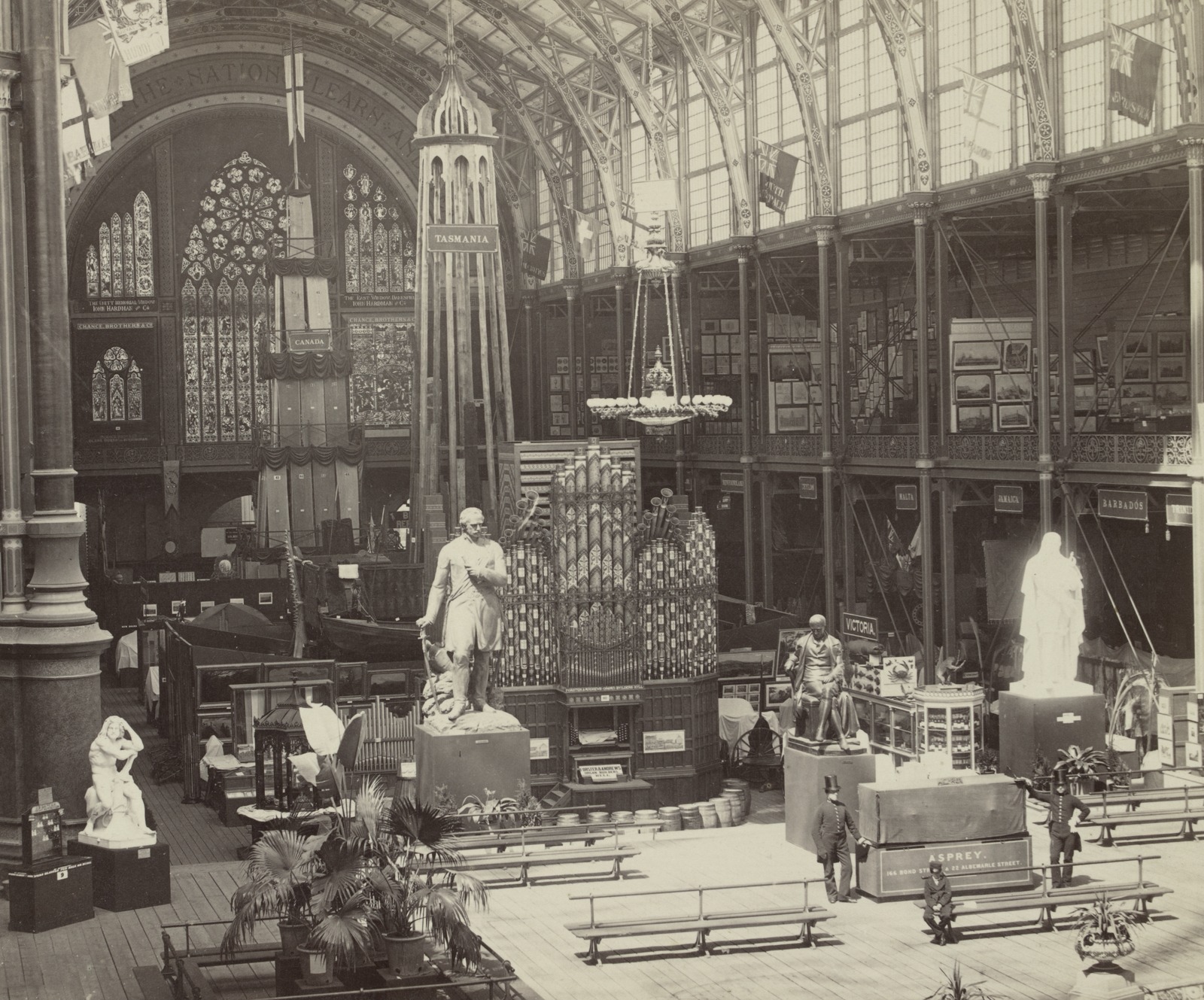
A close up of the relevant portion of the photo (slightly to the right of the upright whale jawbone):
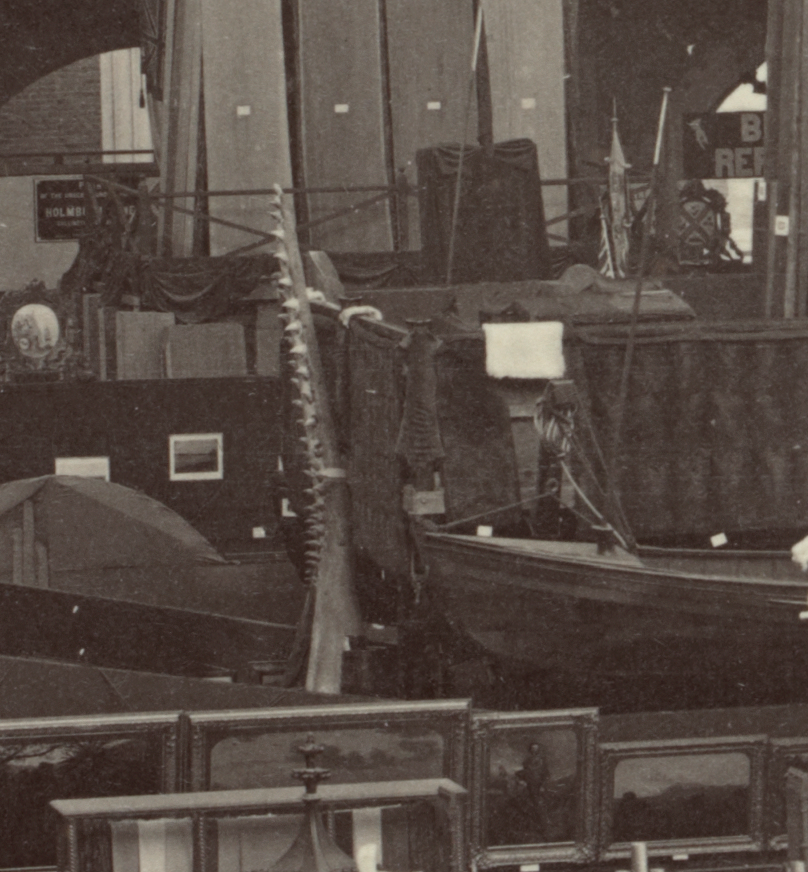
Prior to the discovery of the significance of this photo in early September 2020 (and the subsequent finding of No. 3 as a result of the lead provided by this photo) the earliest known photo of a thylacine or its remains was the Frank Haes photo taken at London Zoo from 1864 (see No. 5 below). What is most remarkable about this discovery is that the skin is not visible unless you zoom in considerably when the only indication that the photo may be of interest is the "Tasmania" sign, which makes its discovery by the eagle-eyed Dianna Scott truly incredible.
An earlier newspaper article (Anonymous, 1861) describes the contents of the Tasmanian portion of the exhibition, which also included a taxidermied specimen and so it is possible that this latter specimen was also photographed. However, I have not been able to find any photo that depicts it yet.
Identity of photographer
Unknown. The State Library of Victoria simply states: "London Stereoscopic & Photographic Company, photographer" (source)
Whereabouts of the original
The photo is housed in the La Trobe Picture Collection, State Library of Victoria (Sweet, 1997)
Reproductions: Sweet, 1997
3. The 1862 London Exhibition Photo (Michael Ryan discovery)
Front view of the stereograph:
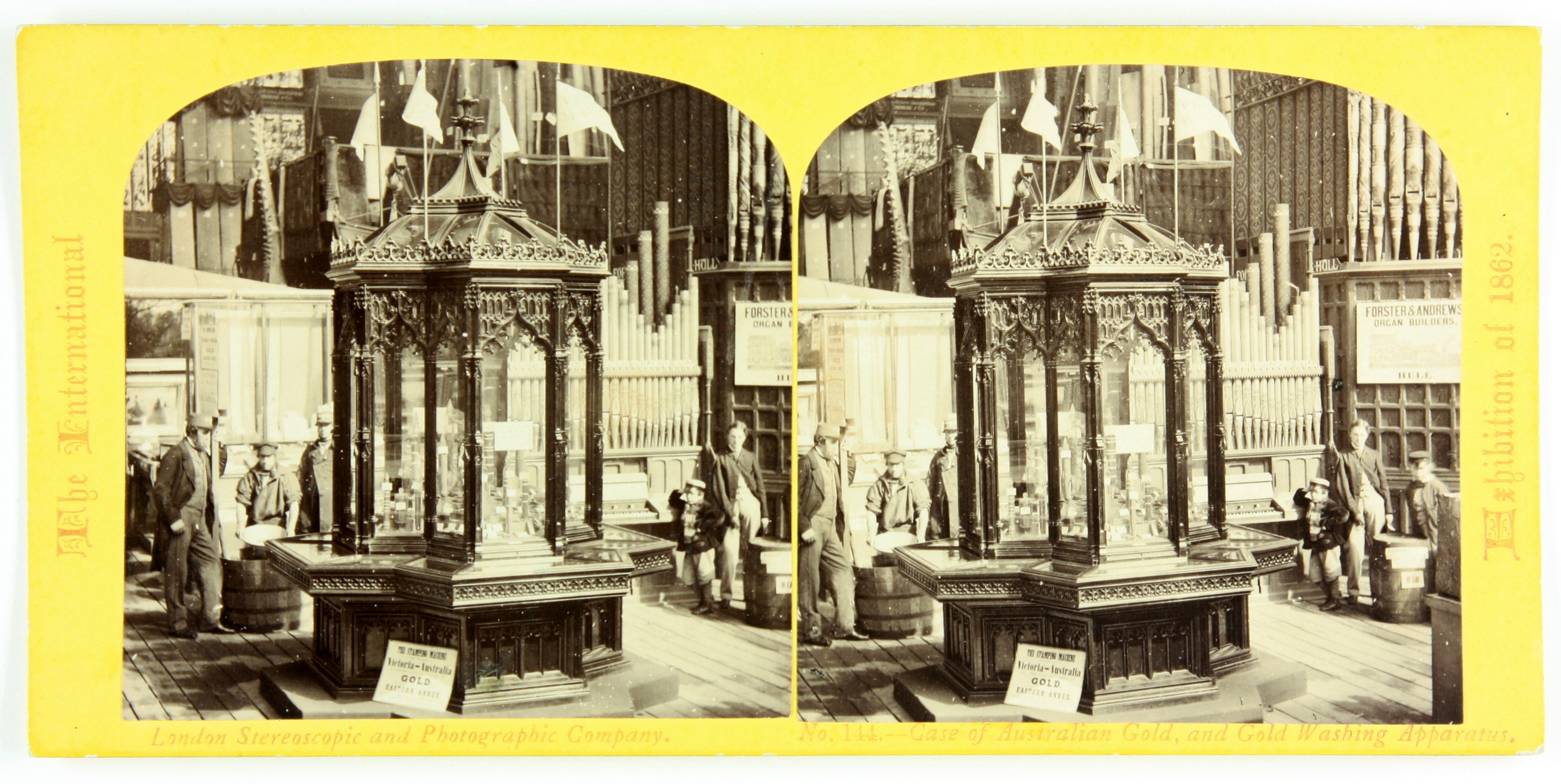
Rear view of the stereograph:
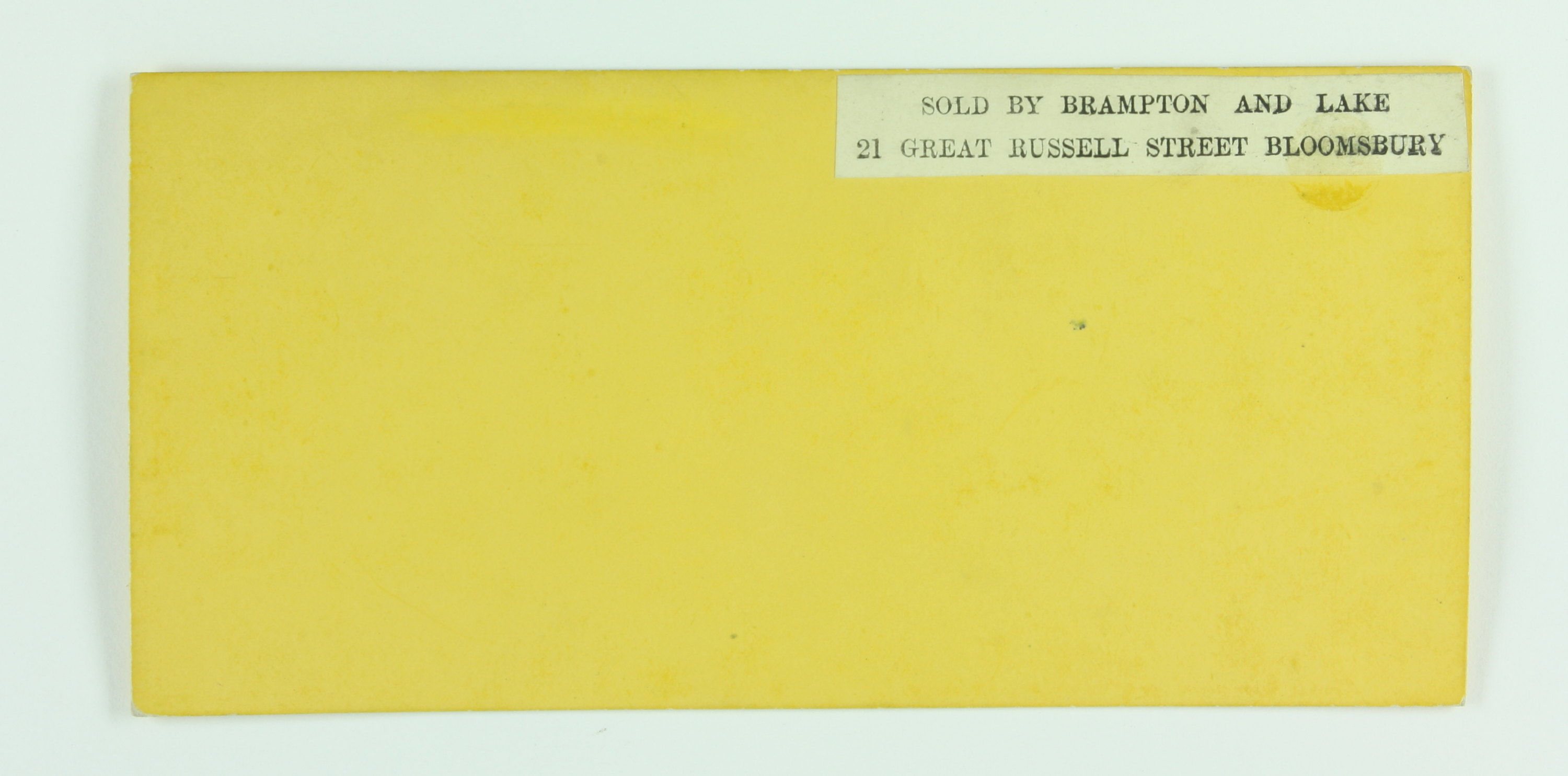
This photo was discovered by Michael Ryan in early September 2020, after Dianna Scott's discovery of photo No. 2 above lead him to search for further possible photos showing the skin.
Identity of photographer
The photographer is unknown.
Whereabouts of the original
Museums Victoria collection (online).
Reproductions: [None known]
4. The 1862 London Exhibition Photo (Jasper Hulshoff Pol discovery)
Front view of the stereograph:
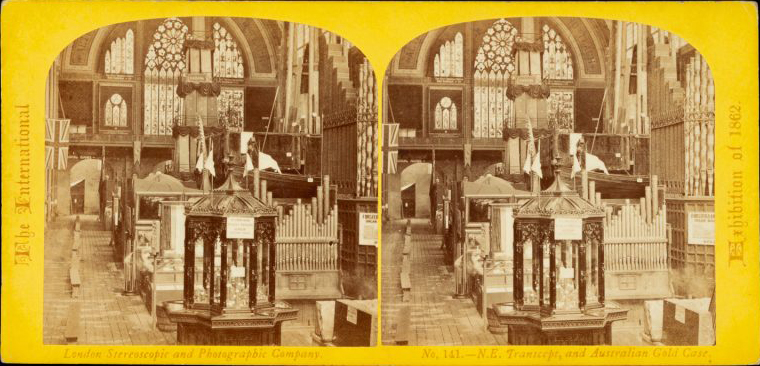
A close up of the relevant portion of the photo (slightly to the right of the upright whale jawbone):
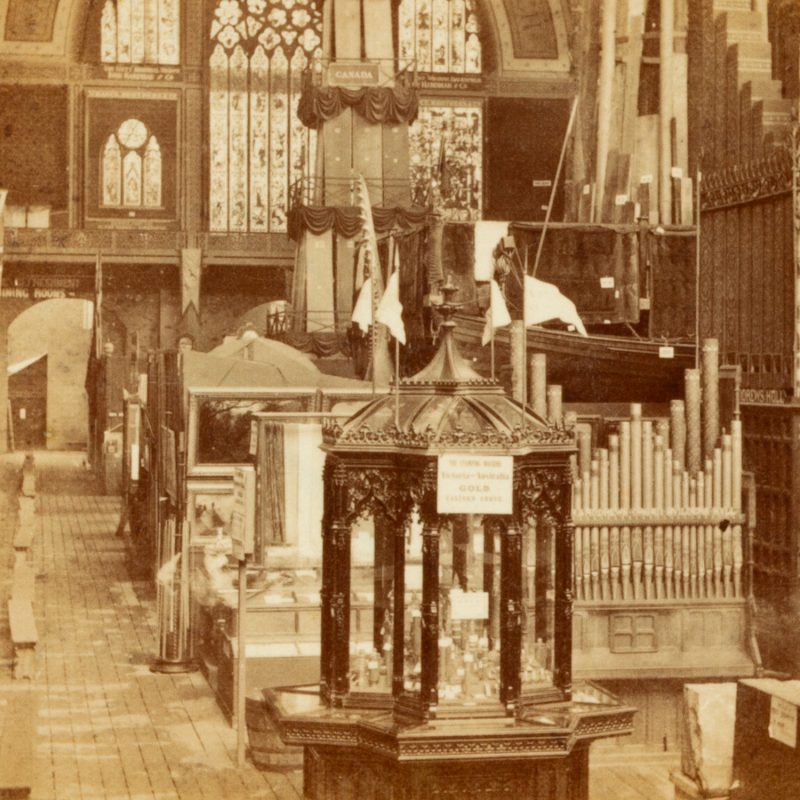
This photo was discovered by artist Jasper Hulshoff Pol in mid-May 2024, who kindly notified me of the find (Jasper Hulshoff Pol, pers. comm. 15 May 2024).
Identity of photographer
The photographer is unknown.
Whereabouts of the original
It is unknown whether the original stereoview survives.
Reproductions: [None known]
5. The 1864 Frank Haes Photo
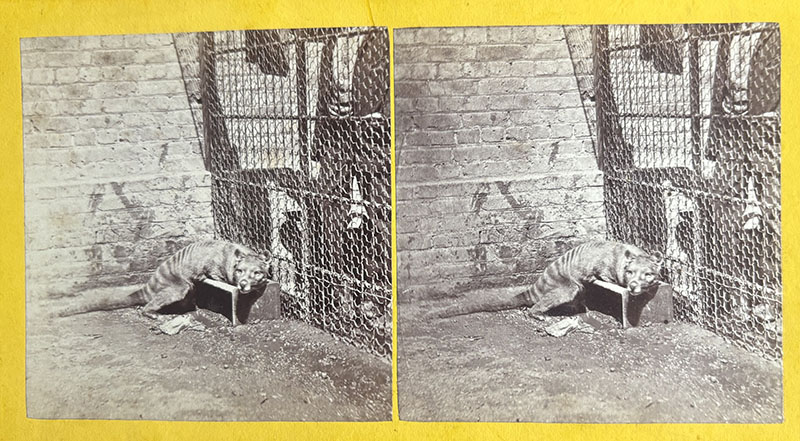
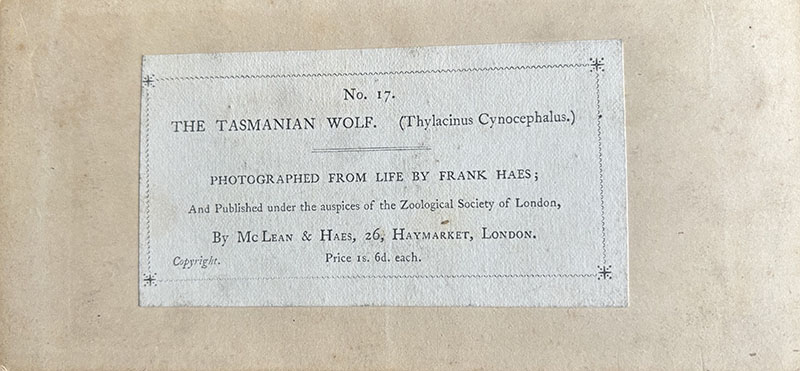
Above: a copy of Frank Haes' stereoview No. 17 of the thylacine from his first series taken at London Zoo in 1864. Held in a private collection. Photo: Ken Wallis. Reproduced with permission.
This was for a long time the only known photo to survive that depicts a living thylacine from before the 20th century. It might thus be assumed to be a much happier affair than the rest of the photos of dead specimens. However, the circumstances of the photo make this false. The animal was chased around its small enclosure until it collapsed, exhausted in its water trough.
The photo itself was rediscovered by London Zoo historian John Edwards (Sleightholme et al., 2016).
Identity of photographer
The original stereo view identifies Frank Haes as the photographer (see Sleightholme et al., 2016).
Whereabouts of the original
The stereo view is in the private collection of John Edwards, while the lantern slide is in the private collection of Dr. Stephen Sleightholme (both Sleightholme et al., 2016). A second stereoview copy has since been reported in the hands of collector Ken Wallis (Sleightholme, 2025).
Reproductions: Maynard & Gordon, 2014:10 [lantern slide only]; Sleightholme et al., 2016; Sleightholme, 2025 [lantern slide only]
6. The 1865 Frank Haes Photo
[The image can be viewed in (Sleightholme, 2025)]
A mystery mammal was noticed in the background of a stereo view of a two-toed sloth (Bradypus didactylus) taken by Frank Haes in 1865 by collector Ken Wallis. This was passed on to Dr. Stephen Sleightholme, who identified the animal as being a thylacine (see Sleightholme, 2025).
Identity of photographer
The original stereo view identifies Frank Haes as the photographer (see Sleightholme, 2025).
Whereabouts of the original
The stereo view copy has since been reported in the hands of collector Ken Wallis (Sleightholme, 2025).
Reproductions: Sleightholme, 2025
6. The 1866-67 Melbourne Intercolonial Exhibition of Australasia Photo [missing]
The Australian catalogue for the Melbourne Intercolonial Exhibition (Anonymous, 1867), under "Products of New South Wales", has the following entry:
"Thylacinus cynocephalus.—Photograph of skeleton." (p. 57)
It is rather natural to suppose that this photograph may be the hypothetical Frederick Frith photo almost a decade after it was taken. After all it is simpler to posit one photo rather than two. However, the photo is listed under New South Wales and not Tasmania, with the former having already ceased to administer the latter
Identity of photographer
The catalogue listing is the only known mention of this photo, and omits any mention of the photographer.
Whereabouts of the original
The photo is not known to survive, but as a photo of a skeleton it's identity could easily be overlooked. Moreover, given the brief description in the catalogue it is not clear where the photo could be if it does survive. Thus it is difficult even contemplating how one might go about trying to find it after all these years. You might have a better chance actually finding a thylacine.
Reproductions: [None known. Survival of photo not guaranteed]
7, 8 & 9. Three photos of thylacine skulls (1868 or prior) [missing]
"I enclose three photographs of the skulls of both animals [i.e. Thylacinus breviceps sp. nov.] in different positions, both very perfect, and that of T. cynocephalus larger than that of the new species."
(Krefft, 1868:296)
Identity of photographer/s
The paper omits any mention of the photographer/s.
Whereabouts of the originals
The photos are not known to survive, but as photos of skulls their true identity could easily be overlooked.
Reproductions: [None known]
10. The 1869 William George Weaver Photo
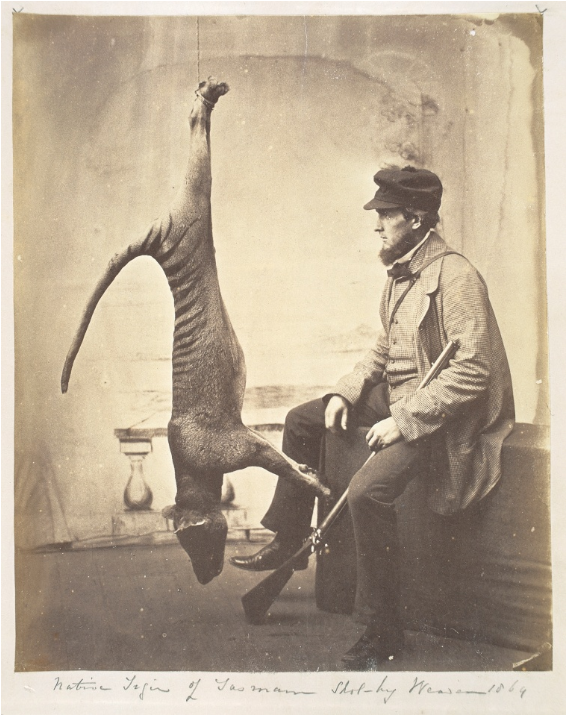
Above: Note the handwriting below the photograph: "native tiger of Tasmania shot by Weaver 1869".
Given the reclusiveness of thylacines, historically described as shy and retiring, it is surprising that the only known 19th century photo of an intact dead specimen was putatively shot rather than trapped or snared. Indeed the last known photo (or rather set of five photos) of a dead specimen was also shot. By farmer Wilf Batty on his family's farm at Mawbanna in the state's north-west, probably on 13 May 1930.
The first reproduction of this image that I am aware of is (Beresford & Bailey, 1981). They give a description of what is depicted: Mr Weaver bags a tiger, 1869 (p. 4). As the handwriting below the photo shows, this is a mere description rather than the actual title on the photo. Yet it appears that some person or persons have misinterpreted this intent, as one now routinely finds the assertion that the photo is (en)titled "Mr(.) Weaver bags a tiger, 1869" (e.g. Owen, 2003, 2004; Thylacine Museum, fourth revision [2013], fifth revision [2017]). Although some authors do correctly described the photo (e.g. Maynard & Gordon, 2014).
Identity of photographer
Curiously, Guiler & Godard (1998:238) lists the Weaver photo in the "Illustration Credits" but the photo does not actually appear in the claimed place in the book (viz. page 98). However, they attribute the photo to Voctor (sic) A. Prout. The Thylacine Museum, fifth revision (2017) is more tentative, noting that it "was possibly taken by Victor Albert Prout".
Whereabouts of the original
According to Maynard & Gordon (2014:22), the original photo was presented by Lady Dry to the Royal Society of Tasmania in 1906, and now resides at the Tasmanian Museum and Art Gallery (TMAG). It has the TMAG registration number Q10661 (K. Medlock, pers. comm. 18 June 2023).
Reproductions: Beresford & Bailey, 1981:4; Archer et al., 1991; Owen, 2003:161, 2004, 2011; Maynard & Gordon, 2014:22; Mooney, 2016; Sleightholme et al., 2016; Owen & Pemberton, 2023
11. The 1876 Romain Talbot magic lantern slide
Front view:

Back view:
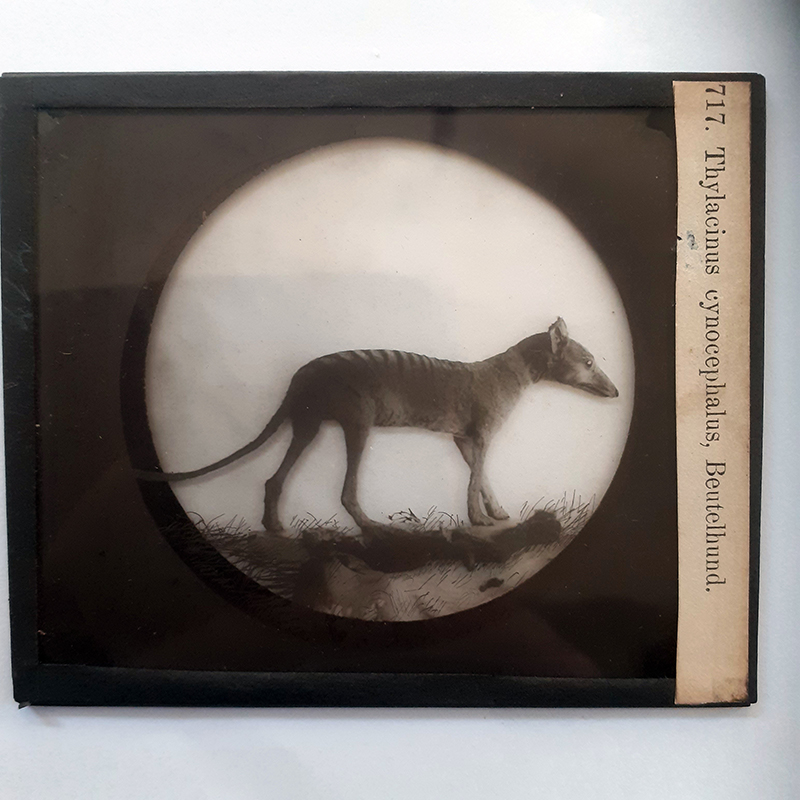
Artist Jasper Hulshoff Pol rescued this and other magic lantern slides from the bin of his former school. According to Dr. Stephen Sleightholme, director of the International Thylacine Specimen Database (ITSD), it does not match any of the 102 taxidermy specimens known to survive (Dr. Stephen Sleightholme, pers. comm. 2 December 2022) and thus almost certainly depicts a specimen that has since been lost. Jasper initially tracked down a July 1879 Max Fritz catalogue listing with the slide in it (Fritz, 1879:21), who is clearly the manufacturer of the slide. But he has since tracked down a Romain Talbot catalogue listing from October 1876 (Talbot, 1876:7), indicating that Max Fritz's production run post-dates the photograph by several years and is not directly associated with it.
Identity of photographer
The photographer is unknown.
Whereabouts of the original
The whereabouts of the original photograph is unknown, although a copy of it exists in the form of this surviving magic lantern slide owned by Jasper Hulshoff Pol.
12. The 1880 Thomas Bather Moore Photo
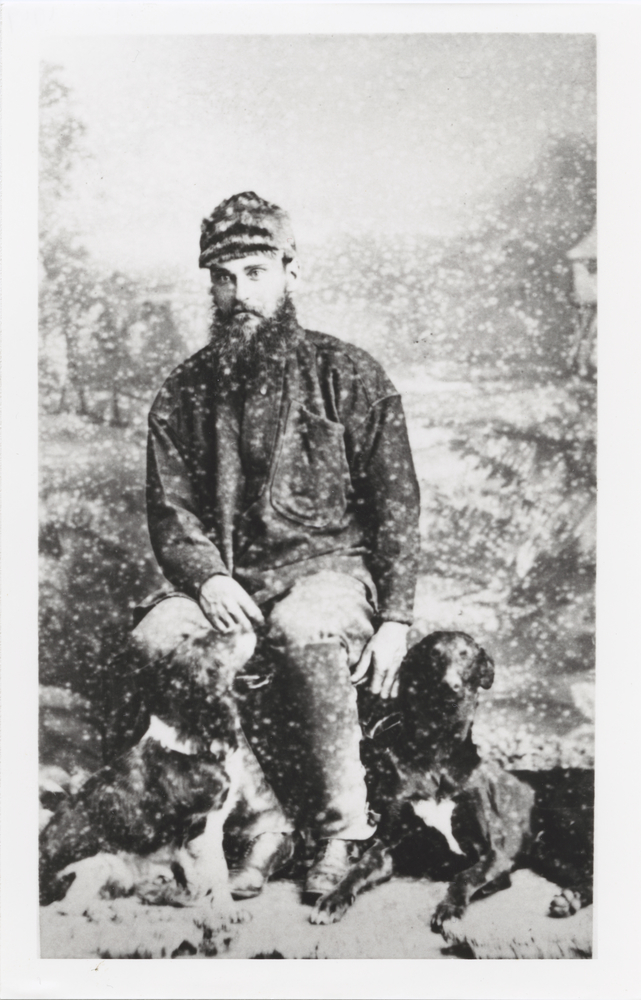
Pictured: explorer Thomas Bather Moore (age 29), with his two dogs Spero (left) and Spiro (right).
Tasmanian historian Nic Haygarth has reproduced the relevant extract from Moore's 1880 diary (Accession TMAG ZM5617):
"Climed [sic] up a hill along the track
With Spero & Spiro my two dogs.
But soon the dogs a scent had found
Rushed on in front the game to find With noses pointing to the ground
Left me some forty yards behind
When lo! I heard a savage sound
Among the ferns hard by
As some ebast upon the ground
Yelled out its last its dying cry ...
In haste upon some mossy logs
My heavy load was flung
And quickly to the barking dogs
...[from?] stones and logs I sprung
Upon the turf there lay quite dead
A beast with stripes upon his coat
Young Spero bit about its head
While Spiro grasped it by the throat
So [?] there a noble tigre [sic?] died
Just as the sun set golden rays [?]
Shed light upon the mountain [?] side
And victors of that savage fray"
Identity of photographer
Unknown to the present author.
Whereabouts of the original
Unknown to the present author, but as it seems to have first been reproduced as late as 1980 (viz. Binks, 1980), it presumably still survives.
Reproductions: Binks, 1980; Guiler & Godard, 1998:151; Haygarth, 2012; Gregory, 2013.
13. The 1884-1894 Buckland and Spring Bay Mother and Pups Photo [tentative date]
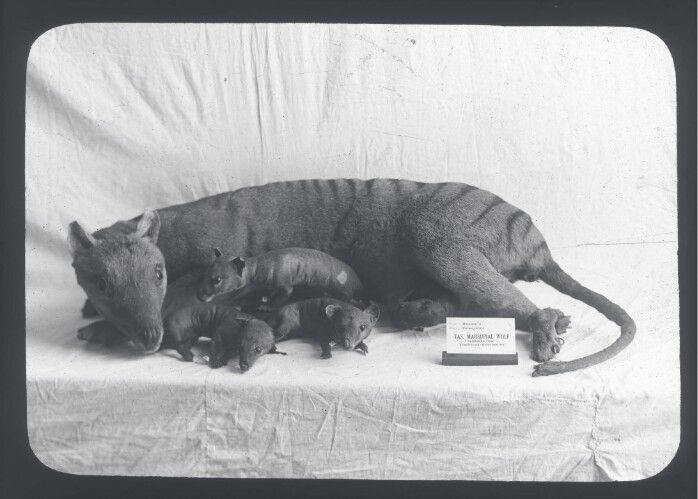
This photo is one of three known (the other two are below) that depicts the only known taxidermy of a mother and her pups/joeys (n=4). The specimens were donated by William Turvey, then treasurer of the Buckland and Spring Bay Tiger & Eagle Extermination Association (Paddle, 2000:142; Maynard & Gordon, 2014:112).
The dating of this photo is tentative, and based upon the seemingly fresher state of preservation of the mother, as contrasted with photo No. 17 below. In particular, she appears to exhibit a large crease at the upper most part of the rear left leg in the later photo which is absent from this photo. Although caution must be eased as it is possible to discern a disturbance of the same basic shape to the same area of the animal in the above photo.
Identity of photographer
This photo is attributed to John Watt Beattie by (Maynard & Gordon, 2014:112).
Whereabouts of the original
QVM.1985.P.1650 [Queen Victoria Museum and Art Gallery accession number] (Maynard & Gordon, 2014:112).
Reproductions: Maynard & Gordon, 2014:112
14. The c.1885 Buckland and Spring Bay Mother and Pups Photo
[The image can be viewed in (Medlock, 2022:397)]
"A female thylacine with her four young, presented to the Tasmanian Museum by the Buckland and Spring Bay Tiger and Eagle Extermination Society. Photographer: Edmond Haldane Cotsworth, c. 1885. Collection: Tasmanian Museum and Art Gallery. Q4451"
(Medlock, 2022:397)
Identity of photographer
Photograph by Edmond Haldane Cotsworth according to (Medlock, 2022:397).
Whereabouts of the original
Tasmanian Museum and Art Gallery accesioned as Q4451 (Medlock, 2022:397).
Reproductions: Medlock, 2022:397
15. The 1887 photo of Margaret Terry (shared by descendant Jennie Harvey Towan)
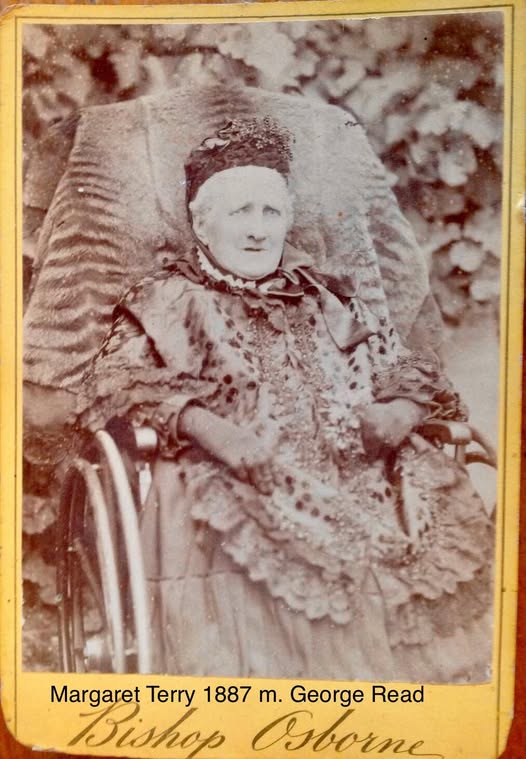
Originally shared by descendant Jennie Harvey Towan in the Tasmanian History Facebook group. The photo depicts Margaret Terry in 1887, two years before she died on 5 June 1889 at age 89 (born 1 May 1800). A three-skin thylacine rug is conspicuously hanging behind her, whose whereabouts are unknown but it must sadly be presumed destroyed as only a single multi-skin rug is known to survive today.
This surviving rug is comprised of no less than 8 skins, and was in private hands until auctioned on 7 September 2002 and jointly purchased by the Tasmanian Museum and Art Gallery (TMAG), Queen Victoria Museum and Art Gallery (QVMAG) and a hotel group for over AU $250,000 (Owen, 2003, 2004; Maynard & Gordon, 2014:27; Schlunke, 2020; Owen & Pemberton, 2023). It is said to have been made around 1903 by Robert David Stephenson (Maynard & Gordon, 2014:27), and was reputedly purchased for three pounds in the early 20th century (Owen, 2003, 2004; Owen & Pemberton, 2023). Although Schlunke (n.d.) suspects a woman's hand. According to a Sydney Morning Herald article covering the auction, the rug "has been owned since the 1930s by the Foster family of Evandale, near Launceston" (Anonymous, 2002). 113 years earlier, the Sydney Morning Herald ran an advertisement for another auction, for "Tasmanian tiger carriage rugs" (Anonymous, 1889a,b), although it is not clear whether these were of single skins or multiple skins.
Identity of photographer
Unknown to me.
Whereabouts of the original
In the hands of her descendants.
Reproductions: [None known]
16. The 1892 Buckland and Spring Bay Male Thylacine
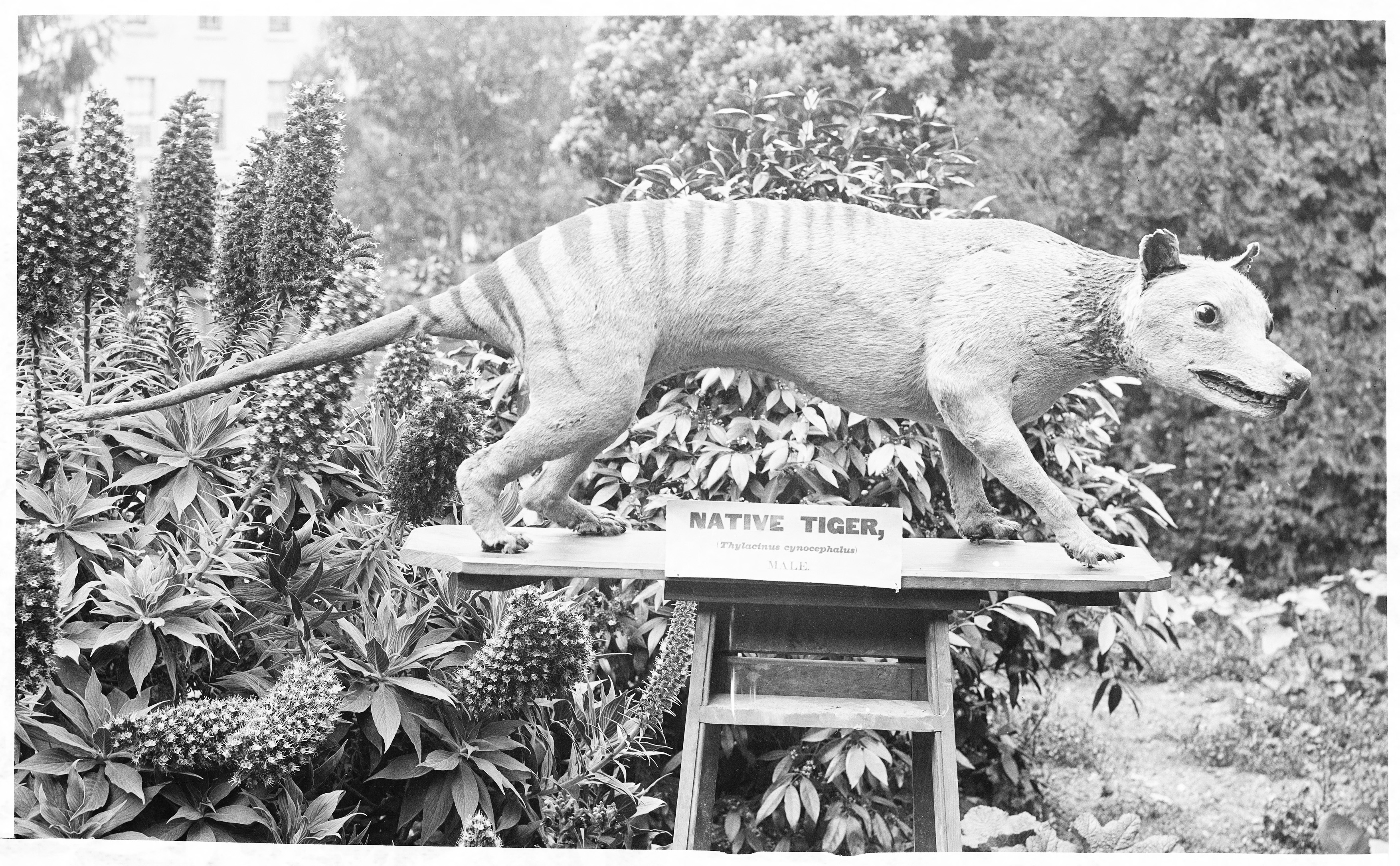
The specimen was donated by William Turvey, treasurer of the Buckland and Spring Bay Tiger & Eagle Extermination Association (Cooper-Maitland, c.1968; but see Paddle, 2000:141)
Identity of photographer
Taken by a member of the Pretyman family (source).
Whereabouts of the original
Held by the State Library of Tasmania, accessioned as NS1013/1/1243 and available online.
Reproductions: [None known]
17. The 1894-95 Buckland and Spring Bay Thylacine Family Photo

The above photograph is in fact a composite of two individual images despite its description on the NLA website ("Image has been separated into two pieces at some stage and later re-joined"), as the background of each of the halves is in fact the same (tree in background and vine (?) growing on fence), as kindly pointed out to me by Kathryn Medlock, Honorary Curator of Vertebrate Zoology at the Tasmanian Museum and Art Gallery (TMAG) (K. Medlock, pers. comm. 18 June 2023). She also notes that "the photographs were probably taken in an area behind the old museum buildings that is now built over" (Ibid.).
This photo (left half of the above composite photo) is the third of three known (from the 19th century) that depicts the only known taxidermy of a mother and her pups/joeys (n=4). The specimens were donated by William Turvey, then treasurer of the Buckland and Spring Bay Tiger & Eagle Extermination Association (Paddle, 2000:142; Maynard & Gordon, 2014:112). Turvey had previously donated a large male (Cooper-Maitland, c.1968; but see Paddle, 2000:141), which may be that standing behind her. The female and her pups/joeys are thought to have been destroyed around 1935 ([Cooper-Maitland, c.1968?;] Maynard & Gordon, 2014:112), although Kathryn Medlock confirms that while the pouch young do not survive, "quite a few bits of it [are] still in the TMAG collection" (K. Medlock, pers. comm. 18 June 2023).
Identity of photographer
Photo attributed to John Watt Beattie (Trove).
Whereabouts of the original
Held by the Tasmanian Museum and Art Gallery (TMAG) accessioned as Q4450 (K. Medlock, pers. comm. 18 June 2023).
Reproductions: Medlock, 2022:398 [original photo of the thylacine family group only (see above)]
Conclusion: Are there other photos?
To jump forward to the 20th century, there are a number of photos of the thylacine that have still never been published, as well as some that remain under copyright. And several more have come to light in the last few decades. Thus it is perfectly possible that somebody out there knows of more photos from the 19th century than I do. Alternatively, there may be undated photos which further research may uncover are from the 19th century. Particularly as, rather than increasing as photography became more common, known and hypothetical 19th century thylacine photos cluster from the late 1850's to the end of the 1860's, with the remainder spread out rather evenly. Except for a notable absence during the 1870's, from which a single photo is known to the present author.
Acknowledgements
I thank Gareth Linnard for pointing out the superior quality of the Weaver photo contained in Nick Mooney's Capeia article. I thank Neil Gill for pointing out the 19th century date of the photo of the taxidermied family associated with the Buckland and Spring Bay Tiger & Eagle Extermination Association (No. 17). Jasper Hulshoff Pol kindly informed me of the magic lantern slide he rescued and the subsequent research he did to identify its date (No. 11). And later notified me of his discovery of photo No. 4. Dr. Stephen Sleightholme conveyed his opinion on the identity of the then 1879 Max Fritz (now 1876 Romain Talbot) lantern slide (No. 11), and informed me of the publication of Kathryn Medlock's book chapter which contains a newly discovered 19th century thylacine photo (No. 14). Kathryn Medlock kindly corrected my account of photo No. 17, as well as added significant extra information to it, and provided me with the registration number for the 1869 Weaver photo (No. 10). I am very grateful to collector Ken Wallis for provisioning me with information about Frank Haes' two series of photos from London Zoo (from 1864 & 1865), and for allowing me to reproduce his photographs (front and back) of the stereoview (No. 5 above).
References:
Anonymous. (1858a). A Native Tiger. The Hobart Town Daily Mercury, Thursday, 20 May, p. 3 |5|.
Anonymous. (1858b). A Native Tiger. Launceston Examiner, Tuesday, 25 May, p. 2 |7|.
Anonymous. (1858c). A Native Tiger. The Age (Melbourne), Wednesday, 26 May, p. 6.
Anonymous. (1858d). ['The body of one of these nearly obsolete animals...']. Empire (Sydney), Monday, 31 May, p. 2.
Anonymous. (1861). Tasmania in the International Exhibition. The Mercury, Tuesday, 3 December, p. 2-3.
Anonymous. (1867). Intercolonial Exhibition of Australasia, Melbourne, 1866-67: Official Record, containing Introduction, Catalogues, Reports and Awards of the Jurors, and Essays and Statistics on the Social and Economic Resources of the Australasian Colonies. Melbourne: Blundell & Co.
Anonymous. (1889). Attractive Unreserved Sale. The Sydney Morning Herald, Saturday, 15 June, p. 16. [thylacine carriage rugs for auction]
Anonymous. (1889). Attractive Unreserved Sale. The Sydney Morning Herald, Thursday, 20 June, p. 11. [thylacine carriage rugs for auction]
Anonymous. (2002). Rarest tiger skin a rugged survivor. The Sydney Morning Herald, 20 August.
Archer, Michael, Hand, Suzanne J. and Godthelp, Henk. (1991). Riversleigh: The Story of Animals in Ancient Rainforests of Inland Australia. Sydney: Reed Books.
Beresford, Quentin and Bailey, Garry. (1981). Search for the Tasmanian Tiger. Hobart, Tasmania: Blubber Head Press. 54 pp.
Binks, C. J. (1980). Explorers of Western Tasmania. Launceston: Mary Fisher Bookshop.
Cooper-Maitland, S. (c.1968). List of Specimens donated to Royal Society of Tasmania Museum 1849-1886. Unpublished paper, TMAG.
Fritz, Max. (1879). Das Scioptikon vervollkommneter Projectionsapparat für den Unterricht: Fünfte Auflage (fifth edition): Juli (July) 1879. Goerlitz, Silesia: Max Fritz. [p. 21]
Gregory, Ron. (2013). Mt Donaldson EL36/2010 Annual Report for period 24th November 2011 to 24th February 2013. Unpublished report prepared March 2013 by Ron Gregory Prospecting. [Thomas Bather Moore diary entry and studio portrait]
Haygarth, Nic. (2012). An ‘Island’ Within an Island: the Maritime/Riverine Culture of Tasmania’s Pieman River Goldfield 1877–85. Journal of Australasian Mining History 10: 55-71.
Krefft, Gerard. (1868). Description of a new species of thylacine (Thylacinus breviceps). Ann. Mag. Nat. Hist. (4) 2: 296-297.
Maynard, David and Gordon, Tammy. (2014). Tasmanian Tiger: Precious Little Remains. Launceston: Queen Victoria Museum and Art Gallery. 127 pp.
Medlock, Kathryn. (2022). Exhibiting Extinction: Thylacines in Museum Display, pp. 392-406. In: Bienvenue, Valérie and Chare, Nicholas (eds.). Animals, Plants and Afterimages: The Art and Science of Representing Extinction. Berghahn Books. 460 pp.
Mooney, Nick. (2016). Thylacine; the Improbable Tiger. Capeia: 20160907.002.
Owen, David. (2003). Thylacine: The Tragic Tale of the Tasmanian Tiger. Crows Nest, New South Wales: Allen & Unwin. xii + 228 pp. [hardback version]
Owen, David. (2004). Tasmanian Tiger, the Tragic Tale of How the World Lost Its Most Mysterious Predator. Baltimore, Maryland: The Johns Hopkins University Press. 240 pp.
Owen, David. (2011). Thylacine: The Tragic Tale of the Tasmanian Tiger. Crows Nest, New South Wales: Allen & Unwin. [paperback version]
Owen, David and Pemberton, David. (2023). Tasmanian Tiger: The tragic story of the thylacine (2nd edition). Crows Nest, New South Wales: Allen & Unwin. xv+ 284 pp.
Schlunke, Katrina. (n.d.). The thylacine buggy rug. Everyday Futures project (National Museum of Australia). Available at: https://everydayfutures.nma.gov.au/project/thylacine-buggy-rug/ [Accessed 30 August 2025]
Schlunke, Katrina. (2020). Thylacine buggy rug, pp. 130-134. In: Muir, Cameron, Wehner, Kirsten and Newell, Jenny. Living with the Anthropocene: Love, Loss and Hope in the Face of Environmental Crisis. NewSouth. 384 pp.
Sleightholme, Stephen R. (2025). Lost in plain sight for 160 years - Frank Haes’ forgotten Thylacine. Australian Zoologist. https://doi.org/10.7882/AZ.2025.031
Sleightholme, Stephen R., Campbell, Cameron R. and Kitchener, Andrew C. (2016). Frank Haes' thylacine. Australian Zoologist 38(2): 203-211. https://doi.org/10.7882/AZ.2016.022
Sweet, J. (1997). Colonial Exhibition Design: The Tasmanian Timber Tower at the London International Exhibition, 1862. Papers and Proceedings, Tasmanian Historical Research Association 44(4): 241-251. [p. 248]
Talbot, Romain. (1876). Das Scioptikon, vervollkommnete Laterna magica für den Unterricht: Vierte Auflage (Fourth Edition): October 1876. Printed by Longrien & Leupold (R. Leupold) in Königsberg. [p. 7]
Tozer, Noel. (2018). Snips & Snaps: The Frith Family: a Nineteenth Century Family of Portraitists, Miniaturists, Caricaturists and Photographic Artists. Self published: Edmund & Alexander.
